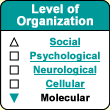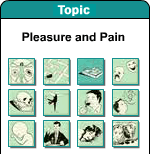| |

 |
 |
 |
Nearly 15% of all men and 30% of all women admit
to a craving for chocolate.
Over 300 substances have
been identified in chocolate. Some of these, including caffeine and theobromine
(another, less powerful stimulant) could actually cause dependency effects. But
the amounts of these substances in chocolate are too small to really have any
effect.
The same goes for phenylethylamine, a substance related to a
family of stimulants called amphetamines. For example, chocolate contains less
phenylethylamine than goat cheese.
Anandamide, a neurotransmitter produced
naturally by the brain, has also been isolated in chocolate. The neural receptors
for anandamide are the same ones to which THC, the main active ingredient in cannabis,
binds. The anandamide in chocolate might therefore contribute to the feeling of
well-being reported by “chocoholics” (though you would have to eat
well over 30 kilos of chocolate to experience effects comparable to one dose of
cannabis!).
Be that as it may, many scientists agree that dependency
on chocolate could simply be due to its taste, which causes a sensation of intense
pleasure that people want to repeat. | | |
| HOW DRUGS AFFECT NEUROTRANSMITTERS | | Dopamine
appeared very early in the course of evolution and is involved in many functions
that are essential for survival of the organism, such as motricity, attentiveness,
motivation, learning,
and memorization. But most of all, dopamine is a key element in identifying
natural rewards for the organism. These natural stimuli such as food and water
cause individuals to engage in approach
behaviours. Dopamine is also involved in unconscious memorization of signs
associated with these rewards.
It has now been established that all
substances that trigger dependencies in human beings increase the release of a
neuromediator, dopamine, in a specific area of the brain: the
nucleus accumbens.  But
not all drugs increase dopamine levels in the brain in the same way.
- Some substances imitate natural neuromediators
and take their place on their receptors. Morphine, for example, binds to the receptors
for endorphin (a natural "morphine" produced by the brain), while nicotine
binds to the receptors for acetylcholine.
- Other
substances increase the secretion of natural neuromediators.
Cocaine, for example, mainly increases the amount of dopamine in the synapses,
while ecstasy mainly increases the amount of serotonin.
-
Still other substances block a natural neuromediator. Alcohol,
for example, blocks the NMDA receptors.
Click
on the names of each of the following drugs to read about how they work and what
effects they have. Alcohol
----- Opiates
(heroin, morphine, etc.) ----- Cocaine
----- Nicotine
Caffeine
----- Amphetamines
----- Cannabis
----- Ecstasy
----- Benzodiazepines
Alcohol Alcohol
passes directly from the digestive tract into the blood vessels. In minutes, the
blood transports the alcohol to all parts of the body, including the brain.
Alcohol affects the brain’s neurons in several ways. It alters their
membranes as well as their ion channels, enzymes, and receptors. Alcohol also
binds directly to the receptors for acetylcholine, serotonin, GABA, and the NMDA
receptors for glutamate.
Click on the labels in the diagram to the right
to see an animation about how alcohol affects a GABA synapse. GABA’s effect
is to reduce neural activity by allowing chloride ions to enter the post-synaptic
neuron. These ions have a negative electrical charge, which helps to make the
neuron less excitable. This physiological effect is amplified when alcohol binds
to the GABA receptor, probably because it enables the ion channel to stay open
longer and thus let more Cl- ions into the cell.
The neuron’s
activity would thus be further diminished, thus explaining the sedative effect
of alcohol. This effect is accentuated because alcohol also reduces glutamate’s
excitatory effect on NMDA receptors.
However, chronic consumption of
alcohol gradually makes the NMDA receptors hypersensitive to glutamate while desensitizing
the GABAergic receptors. It is this sort of adaptation that would cause the state
of excitation characteristic of alcohol withdrawal.
Alcohol also helps
to increase the release of dopamine, by a process that is still poorly understood
but that appears to involve curtailing the activity of the enzyme that breaks
dopamine down. General links about alcohol: | | |
|
|




